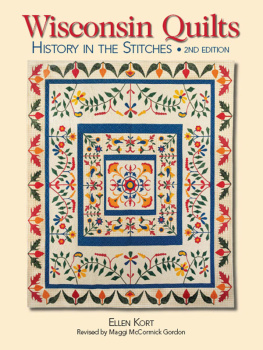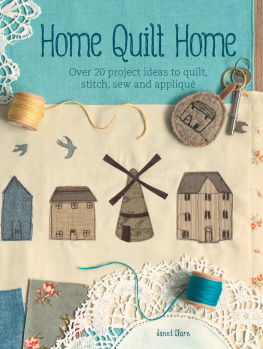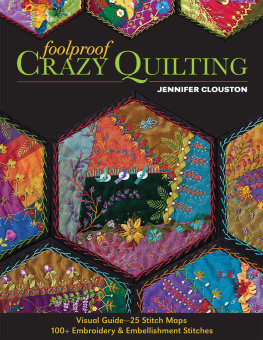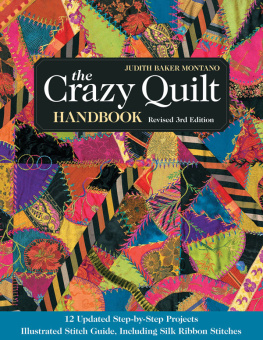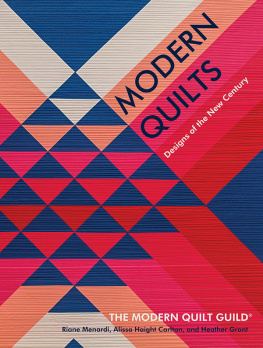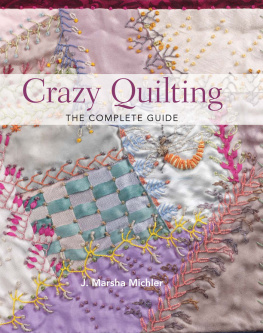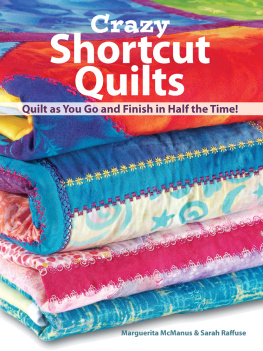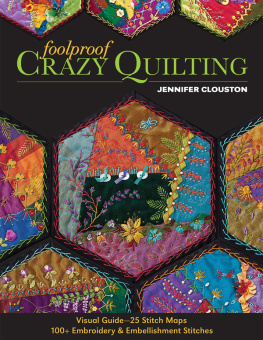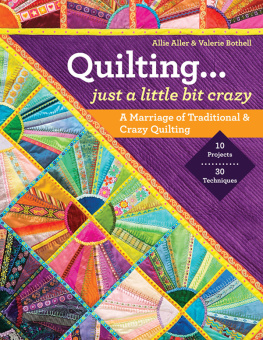
Our lives are patchwork, and it depends on us a good deal how the bright and dark bits get put together so that the whole is neat, pretty, and useful when it is done... Every task, no matter how small or homely, that gets well and cheerfully done, is a fine thing; and the sooner we learn to use up the dark and bright bits (the pleasures and pains, the cares and duties) into a cheerful, useful life, the sooner we become real comforters.
Louisa M. Alcott, Pattys Patchwork, Aunt Jos Scrap-Bag

CRAZY QUILTS
History Techniques Embroidery Motifs
Cindy Brick
Foreword by Nancy Kirk, Crazy Quilt Society founder

First published in 2008 by Voyageur Press, an imprint of MBI Publishing Company LLC, Galtier Plaza, Suite 200, 380 Jackson Street, St. Paul, MN 55101 USA
Copyright 2008, 2011 by Cindy Brick
Photographs and artwork 2008 by sources as noted
All rights reserved. With the exception of quoting brief passages for the purposes of review, no part of this publication may be reproduced without prior written permission from the Publisher.
The information in this book is true and complete to the best of our knowledge. All recommendations are made without any guarantee on the part of the author or Publisher, who also disclaim any liability incurred in connection with the use of this data or specific details.
We recognize, further, that some words, model names, and designations mentioned herein are the property of the trademark holder. We use them for identification purposes only. This is not an official publication.
MBI Publishing Company titles are also available at discounts in bulk quantity for industrial or sales-promotional use. For details write to Special Sales Manager at MBI Publishing Company, Galtier Plaza, Suite 200, 380 Jackson Street, St. Paul, MN 55101 USA
Editors: Margret Aldrich and Amy Rost
Designer: Sara Holle
Printed in China
Digital edition: 978-1-61060-133-7
Softcover edition: 978-0-7603-4009-7
Library of Congress Cataloging-in-Publication Data
Brick, Cindy.
Crazy quilts : history, techniques, embroidery motifs / by Cindy Brick.
p. cm.
ISBN-13: 978-0-7603-3237-5 (hardbound w/jacket)
1. PatchworkPatterns. 2. EmbroideryPatterns. 3. Crazy quiltsUnited States
History. I. Title.
TT835.B6993 2008
746.46041dc22
2007030862
On the front cover:
Fringed Crazy detail. See to view full quilt. (Minnesota Historical Society)
Frontispiece:
Victorian Crazy | Date: ca. 1886 | Maker: Unknown | Size: 76 x 65
This glorious Crazy quilt is made from silks and velvets, and it includes an unusual border of Kate Greenawayinfluenced figures. (Fenimore Art Museum, Cooperstown, New York. Photograph by Richard Walker.)
On the dedication page:
An early 1900s trompe loeil postcard (woman at left), complemented by a nineteenth-century man with silk checkered tie. (No doubt the tie scraps went into a Crazy quilt!)
On the contents page:
A mix of nineteenth- and twentieth-century Crazy ephemera, including fabric and pattern catalogs, cigarette silks, trade cards, ribbons, and more. The late nineteenth century, especially, had an incredible amount of Crazy-related items for resale and giveaway. (Photograph by Teressa Mahoney, Forever Yours Photography)
On the back cover:
Main, Victorian Crazy (Fenimore Art Museum, Cooperstown, New York. Photograph by Richard Walker.)
Inset, trade card, ca. 1886.
DEDICATION
For Nancy Kirk, my dear, Crazy friend. And for David. Always David.



CONTENTS
PART ONE
THE HISTORY OF THE CRAZY QUILT
PART TWO
HOW TO MAKE A CRAZY QUILT
ACKNOWLEDGMENTS
This book has been in the making for so many years. And over that time, many other peoples ideas and contributions have influenced my own. I owe much to the great scholars of Crazy history, especially Virginia Gunn. A Quilters Newsletter editorial assignment and Penny McMorriss thought-provoking book Crazy Quilts started me on this road; Nancy Kirk from the Crazy Quilt Society was the one to point out the signposts and set the pace. Dee Stark has challenged and inspired my thoughts on the origins and meanings. And some of the greatest Crazy quilters, restorers, and teachers have influenced my own work, including Leslie Levison, Betty Pillsbury, Chris Dabbs, Camille Cognac, and Judith Baker Montano.
I am grateful for the quilt-loving friends Ive made over the years, including the editors and artists at Quilters Newsletter and McCalls Quilting. I am proud to call them friends and colleagues. Thanks especially to Barbara, Vivian, Jan and Beth, Sandee, Ellie, and to Barbara Smith, as well. I appreciate the thoughts, ideas, and encouragement of fellow appraisers, especially Newbie Richardson, Kathy Kansier, Sally Ambrose, Carol Pratt, Vivien Sayre, and dear Teddy Pruett, whose style is always just a little bit ...well, you know. A thankful nod to Merikay Waldvogel, who wouldnt take a casual answer, but forced me to think about it. And love to Constance Mullans for her thoughtful questions and encouragement.
There are also the many dear friends gained through the Crazy Quilt Society, the Quilt Restoration Society, and the Quilt Heritage Listserv (QHL), including Mary Waller, Kris and John Driessen, Bill and Nancy Kirk (Bill now gone, but never forgotten), Joan Stevens, Gloria Hall, Carolyn Ducey, Mary Ghormley, Sandy Bonsib, Xenia Cord, and others. They made me think things through and provided many a moment of pure joy. This Crazy life wouldnt be the same without any of you in it.
Thank you also to the many institutions and collectors who loaned their quilts to be shared in this book. Their kindness and generosity is much appreciated. Please note that all quilt dimensions given are approximate. All paper ephemera and memorabilia come from the collection of the author, unless otherwise indicated.
Thank you to my long-suffering and patient editors at Voyageur Press, Margret Aldrich and Amy Rost; see, I made it! Thanks also to my designer Sara Holle.
But most of all, I could not do this without my family, who have put up with Mom in near-permanent newsletter mode and stuff everywhere for years. Thanks, David, Jess, and Angel. The fourth member of this family will always love you.
AUTHORS NOTE
In Jane Austens Persuasion, one of the characters says, I do not think I ever opened a book in my life which had not something to say upon womans inconstancy. Songs and proverbs all talk of womans fickleness. But... these were all written by men [emphasis mine].
Anyone who does quilt and textile research struggles with the same problem. For hundreds of years, patchwork and other forms of needlework were considered in the realm of women. These needle arts were genteel and useful, of course, but hardly important enough for writersthe majority of whom were maleto write about.
Next page

